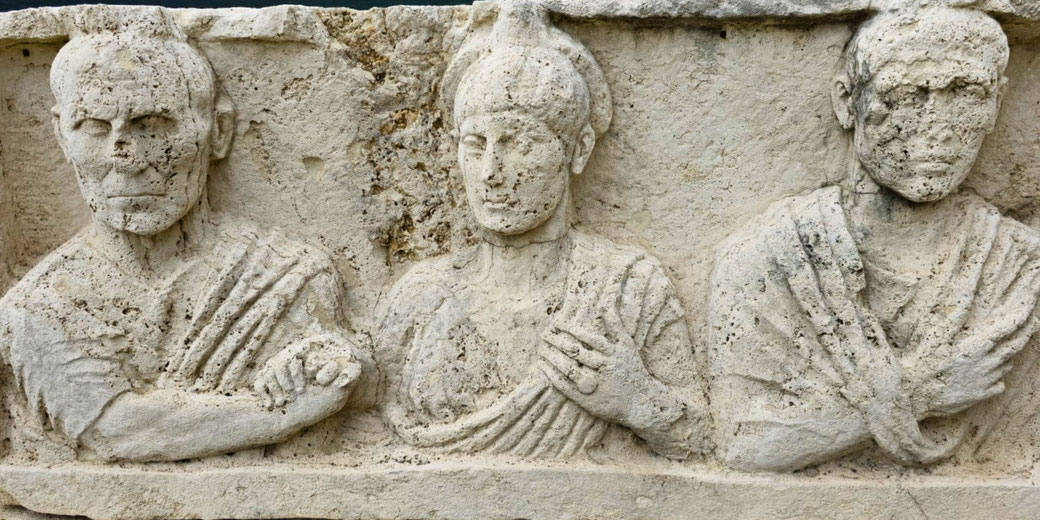
Lucius Cornelius Sulla is an infamous figure in Roman history. His rise to power, underscored by a blend of military brilliance and political strategy, culminated in a reign that would forever alter the course of Roman history.
At the heart of his legacy are the infamous proscriptions, a series of measures that saw the state-sanctioned persecution and murder of his political enemies.
But what drove Sulla to implement such drastic measures?
How did these proscriptions reshape Roman society and politics?
And what can Sulla’s actions tell us about the fragility of political systems and the nature of power?
Who was Lucius Cornelius Sulla?
Born into a patrician family in 138 BCE, Sulla’s early life gave little hint of the military and political prowess he would later display.
His ascent to prominence in the Roman Republic was marked by a combination of military skill, political acumen, and a ruthless determination to assert his authority.
Sulla’s military career began in the Jugurthine War, where his strategic brilliance first came to the fore.
However, it was his command in the Social War (91–88 BCE) against Rome’s Italian allies that solidified his reputation as a formidable military leader.
His success on the battlefield was complemented by his political savvy. In 88 BCE, amidst a deeply fractured Roman political landscape, Sulla was appointed consul and subsequently given command of the war against Mithridates VI of Pontus, a critical conflict for Rome’s eastern territories.

Get free updates from History Skills!
Receive the latest articles, free resources, and more from History Skills straight to your inbox.
I consent to receiving emails and personalized ads.
However, Sulla’s path to power was anything but smooth. His rivalry with Gaius Marius, a prominent military leader and statesman, led to a series of conflicts that would eventually plunge Rome into civil war.
Sulla’s unprecedented march on Rome in 88 BCE marked a turning point in Roman history, breaking a longstanding taboo against using a Roman army against the city and setting a precedent for future civil conflicts.
Once in power, Sulla’s rule was characterized by a ruthless consolidation of power.
His reforms of the Roman political system, though aimed at strengthening the authority of the Senate, also served to centralize power in his own hands.
It was during this time that Sulla instituted the proscriptions, a series of political purges that targeted his enemies and reallocated their wealth and properties, often to his own supporters.
These actions, while securing his position, also instilled a climate of fear and uncertainty in Roman society.
 © History Skills
© History Skills
The political tensions that justified the violence
The Roman Republic, traditionally governed by a complex balance of power among the Senate, the magistrates, and the popular assemblies, was increasingly strained by internal rivalries and external threats.
The social and political fabric of Rome during this time was heavily influenced by the struggle between the optimates and the populares.
The optimates, primarily the aristocratic elite, sought to maintain the status quo and their privileged position.
In contrast, the populares, led by figures like Gaius Marius, aimed to implement reforms that favored the broader population, including the plebeians and the Italian allies who sought Roman citizenship.
These tensions were further exacerbated by economic disparities and the concentration of wealth and land in the hands of a few elite families.
Military conquests and expansion played a significant role in shaping the political climate.
Victories in foreign lands brought immense wealth and glory to Rome but also led to the rise of powerful military leaders who commanded the loyalty of their armies.
This era saw the emergence of military leaders as significant political players, a development that would eventually challenge the traditional Republican values and structures.
The period preceding the proscriptions was also characterized by a series of social and political reforms aimed at addressing the growing discontent among Rome’s lower classes and allies.
These reforms, however, often met with stiff resistance from the Senate and the conservative elite, leading to a cycle of political deadlock and social unrest.
Into this volatile mix stepped Sulla, whose rise to power coincided with, and was partly propelled by, the deepening fractures within Roman society.
 © History Skills
© History Skills
The brutal implementation of the proscriptions
Proscriptions in ancient Rome, particularly under Sulla, were a drastic political tool that combined legalized murder with confiscation of property.
The concept of proscription originated as a formal list of individuals deemed enemies of the state, whose lives and properties were forfeited.
Under Sulla, this tool was used with devastating effect, transforming personal vendettas and political rivalries into a state-sanctioned purge.
When Sulla assumed control of Rome after his victory in the civil war against Marius and his allies, he found himself in a position to fundamentally reshape the political landscape.
In 82 BCE, he assumed the title of dictator, granting him extraordinary powers.
One of his first actions was to introduce the proscriptions. The names of his enemies, real or perceived, were publicly listed, offering rewards to anyone who killed them.
This decree not only legalized the murder of his political opponents but also incentivized it, turning the Roman populace into potential executioners.
The implementation of these proscriptions was as methodical as it was brutal.
Lists were posted in public places, naming those who were proscribed. The condemned had no recourse to trial or defense; their fate was sealed by their inclusion on the list.
Once killed, their properties were confiscated and often redistributed to Sulla’s supporters, further entrenching his power and rewarding his allies.
This wave of terror also served as a warning to any who might oppose Sulla’s rule, instilling fear across Rome.
The proscriptions were not random acts of violence but a calculated political strategy.
By eliminating his opponents and confiscating their wealth, Sulla sought to dismantle the power structures that opposed him and to create a new elite loyal to him.
 © History Skills
© History Skills
Who were the victims of the proscriptions?
The proscriptions initiated by Sulla in 82 BCE targeted a wide array of individuals, from prominent political figures to lesser-known citizens, leaving a trail of devastation in their wake.
Among the most notable victims were those who held significant influence in Roman politics and society, as well as individuals who posed a direct threat to Sulla’s power or were simply caught up in the turmoil of the times.
One of the most prominent victims was Quintus Lutatius Catulus, a respected statesman and former Consul who had been a colleague of Sulla.
Catulus had played a key role in the defense of Rome against the Cimbri alongside Marius, and his suicide in the wake of the proscriptions highlighted the indiscriminate nature of Sulla’s campaign.
The proscriptions also targeted members of the equestrian order and wealthy individuals whose only crime was their considerable fortunes, which made them attractive targets for confiscation.
This indiscriminate targeting served to fill Sulla’s coffers and reward his followers with wealth and property, effectively buying their loyalty.
The proscriptions were not limited to individuals but also extended to entire groups.
Sulla targeted the supporters and allies of his political rival, Gaius Marius, and the populares faction.
This included senators, tribunes, and other officials who had sided with Marius during the civil war.
The impact on the Senate was profound, with about one-third of its members either killed or fleeing into exile.
This purge allowed Sulla to reshape the Senate, filling it with his supporters and fundamentally altering the balance of power within the Roman Republic.
The sheer number of victims, which some ancient sources claim ranged in the thousands, underscored the proscriptions’ brutality.
The fear and chaos generated by this period were pervasive, with many Romans living in constant fear of being added to the list.
Families were torn apart, fortunes were lost, and the political landscape of Rome was irrevocably changed.
The social and economic chaos caused
Economically, the confiscation and redistribution of wealth and property during the proscriptions drastically altered the distribution of wealth in Roman society.
Properties of the proscribed, often substantial estates, were seized and sold at public auction, frequently at undervalued prices.
This sudden influx of property and wealth into the market benefited those aligned with Sulla, often at the expense of the traditional elite.
Many of Sulla’s soldiers and supporters were enriched through this process, leading to the rise of a new class of wealthy individuals.
This shift in wealth also had a destabilizing effect on the Roman economy, as the traditional economic order was upended.
Socially, the proscriptions unleashed a wave of fear and uncertainty across Rome.
Families of the proscribed were often left destitute and dishonored, with their familial lines sometimes coming to an abrupt end.
The social fabric of Rome was torn apart, as trust within the community eroded under the constant threat of betrayal and denunciation.
Relationships between patrons and clients, a cornerstone of Roman society, were strained as loyalty was frequently tested.
The proscriptions also had a lasting impact on Roman culture and values. The sanctity of the Roman Senate and the rule of law were undermined, as the proscriptions bypassed traditional legal processes.
The use of violence and terror as political tools was normalized, setting a dangerous precedent for future Roman leaders.
This period of bloodshed and fear contributed to a growing cynicism and disillusionment with the ideals of the Republic, paving the way for the rise of autocratic rule.
Furthermore, the proscriptions altered the course of Roman political life.
The Senate, once a body of Rome’s most distinguished leaders, was now filled with Sulla’s supporters, many of whom lacked the experience or the traditional qualifications for the role.
This shift weakened the Senate’s effectiveness and prestige, contributing to the gradual decline of the Republic.
Why Sulla stopped the proscriptions
Sulla eventually ended the proscriptions in 81 BCE, after achieving his objectives.
Sulla’s retirement in 79 BCE was as unprecedented as his rise to power.
Leaving the dictatorship voluntarily, he sought to return to a more traditional Roman life.
His life, however, left a profound impact on the Roman Republic, setting a precedent for political purges and the use of state power for personal vendettas in the years to come.
Sulla’s implementation of the proscriptions is often cited as an example of his ruthlessness and willingness to employ terror as a means of political control.
The proscriptions not only resulted in significant loss of life and the destabilization of Roman society but also set a dangerous precedent for political purges in Roman history.
In the broader scope of Roman history, Sulla’s dictatorship is sometimes seen as a precursor to the more enduring autocratic rule of the Roman Empire.
His concentration of power and undermining of Republican institutions highlighted the fragility of the Republican system and paved the way for future leaders, like Julius Caesar and Augustus, to seize control.
 © History SkillsLearn more about Ancient Rome
© History SkillsLearn more about Ancient Rome





